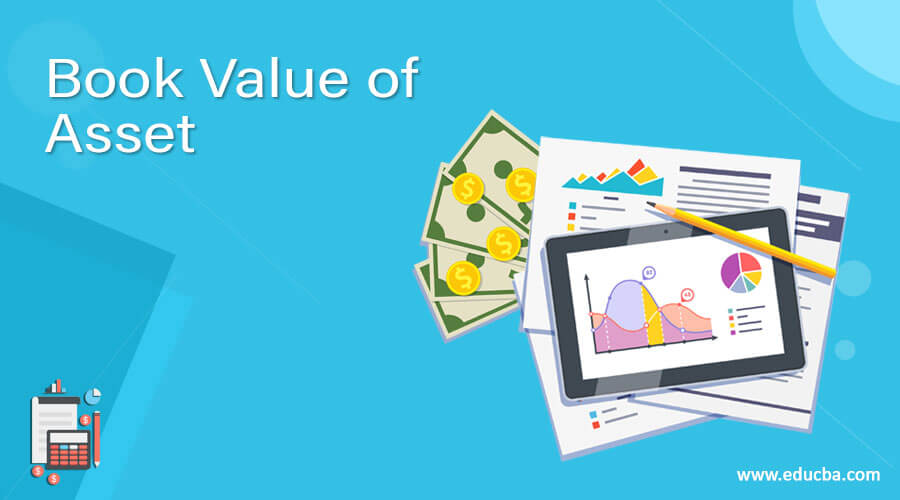Updated July 11, 2023

What is Book Value of Asset?
The book value of the asset is termed as the value that the company or an organization records in its books for a given period. The business determines the B.V of assets as the difference between the original historical cost and the accumulated depreciation.
Explanation
The B.V of assets can be accessed on the balance sheet of the business. It can be described as the net asset cost when accumulated depreciation is deducted from the total fixed asset cost. It is also determined as the difference between total and intangible assets such as goodwill, patents, and other liabilities.
Typically book value has two broad applications. In the event of liquidation, let the shareholders know how much they would be entitled to get. It helps the business perform a comparative analysis between the asset’s market value and the B.V of the asset. By doing such an analysis, the analyst can determine whether the asset is underpriced or overpriced.
Formula for Book Value of Asset
The B.V of the asset is determined as shown below: –
- The cost of the asset on the date of acquisition is the original cost of the asset.
- Depreciation is the non-cash expense that is deducted from the cost of the asset during each financial period.
- Impairment cost is the cost that permanently lessens the financial or economic value of the asset.
Example of Book Value of Asset
Let us take the example of ABC corporation. The business purchased an asset for $50,000, which has a useful life of 10 years. Help the management determine the B.V of assets at the end of the financial period.
Solution:
Compute the depreciation expense of the asset basis the straight-line method:
- Depreciation = $50,000 / 10
- Depreciation = $5,000
Ending Balance of the Asset is calculated as
- Ending Balance of the Asset = $50,000 – $5,000
- Ending Balance of the asset = $45,000
Therefore, at the end of year 1, the B.V of the asset be $45,000. Perform the following computations in excel to arrive at the book value of the asset: –
The following would be the results: –
How is the Book Value of Asset Included in the Balance Sheet?
The B.V of the fixed asset on the balance sheet is displayed in the asset section of the balance sheet. It reflects the net asset value once the accumulated depreciation and other liabilities are deducted from the beginning value of the asset at the end of each financial year.
Importance of Book Value of Asset
With the dynamic change in the trends within the market, the B.V of the asset decreases or increases concerning the asset’s demand in the market. The book value of the asset varies with different locations where the asset is used. Different countries may have other laws as to how they maintain the asset and how they transport assets. Hence, varying book values can be used to compare the asset’s market value.
The B.V of an asset may be higher or lower than that of a similar asset as the latter may be either over-utilized or under-utilized. The book value appreciates for assets such as shares and debentures if the business issues a more significant number of shares or debentures.
Advantages
Some of the advantages are:
- The B.V of the asset can be determined for both fixed and intangible assets. The book value of the machinery and buildings could be determined by deducting the accumulated depreciation from the original cost. Similarly, intangible assets such as shares and debentures can be valued at their fair value.
- The B.V can be determined through the life of the asset. The book value is updated at the end of the period. After the end of the useful life of the asset, the asset has some book value. The book value at the end of the valuable life purely depends upon the value of the depreciation scope.
- The book value of the asset helps the stakeholders know the practical value of the asset once the asset is sold off. Additionally, the book value can be compared with the asset’s market value to determine whether the asset is reasonably priced or under-priced.
Disadvantages
Some of the disadvantages are:
The book value as the value of the asset has several disadvantages. It generally does not align with the market value of the asset. It may be a value that is in proximity to the market value of the asset but still by far remains de-aligned. Book value cannot be used as the indicator of growth in the value of the company’s assets and its overall performance. Specific business outperforms delivering business proposition, but if the book value is compared with its earnings, it tends to reduce the overall valuation ratios.
There is always a possibility that the book value is incorrectly determined. The book value depends on several underlying factors that may not help resolve the accurate value. The book value is valued on only a specific date or specific frequency and not on a real-time basis. This makes the dependency on the book value has limited scope. The value may modify at the later stage of the asset life.
Conclusion
The book value of the asset can be termed as the method of valuing the asset’s actual value and can be regarded as the developing method to arrive at the asset’s value. The value can be overstated or understated with the asset’s market value. It could be located in the asset section of the balance sheet.
Recommended Articles
This is a guide to Book Value of Asset. Here we also discuss the introduction and importance of book value of asset along with advantages and disadvantages. You may also have a look at the following articles to learn more –

